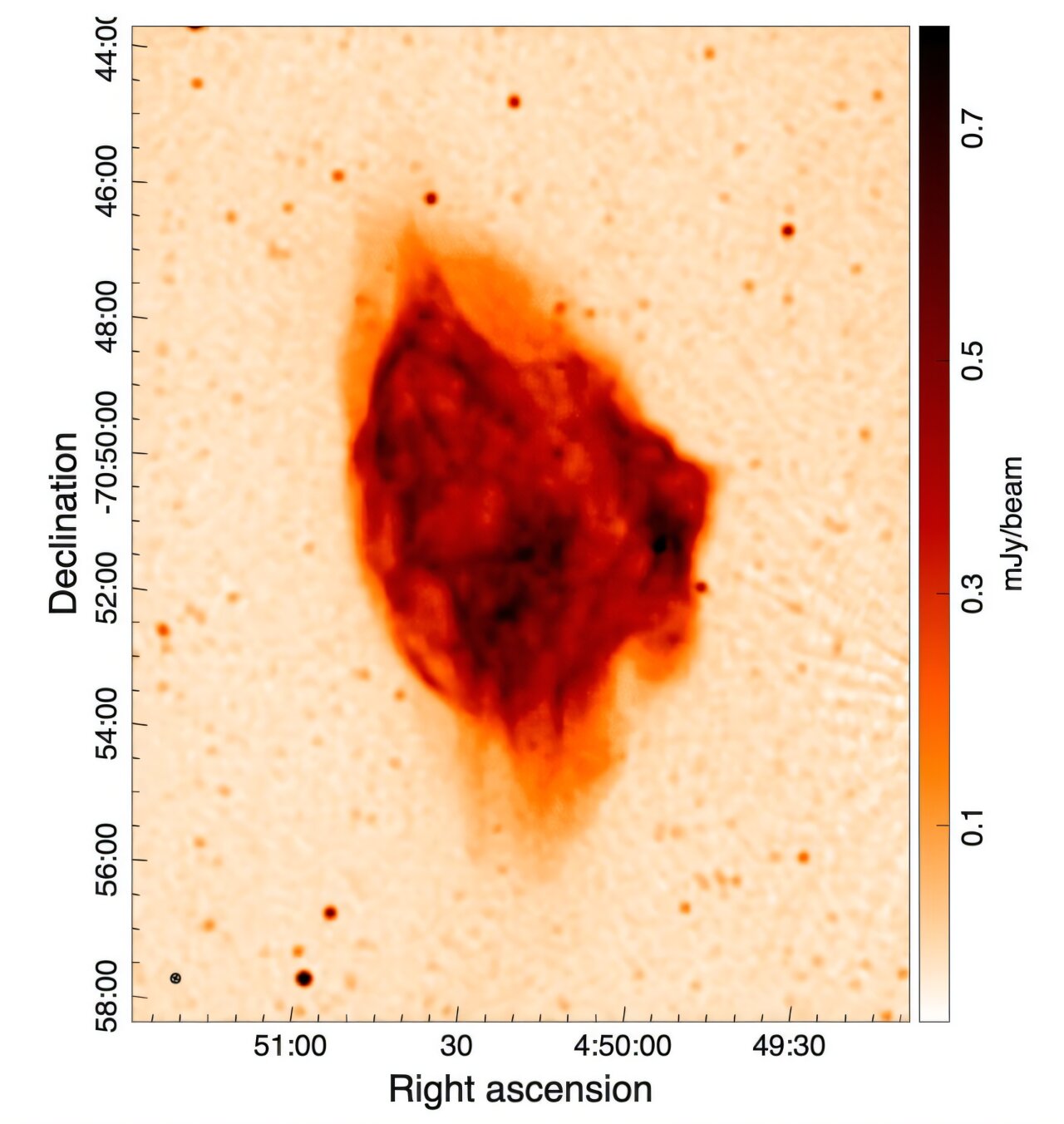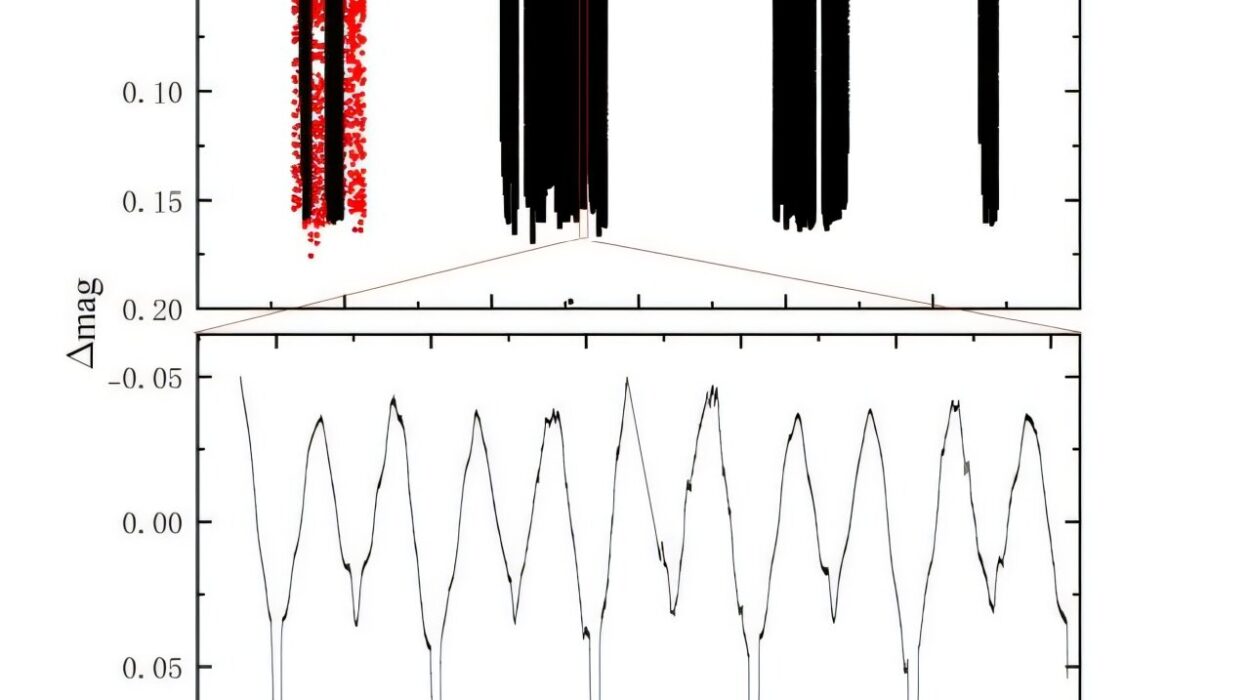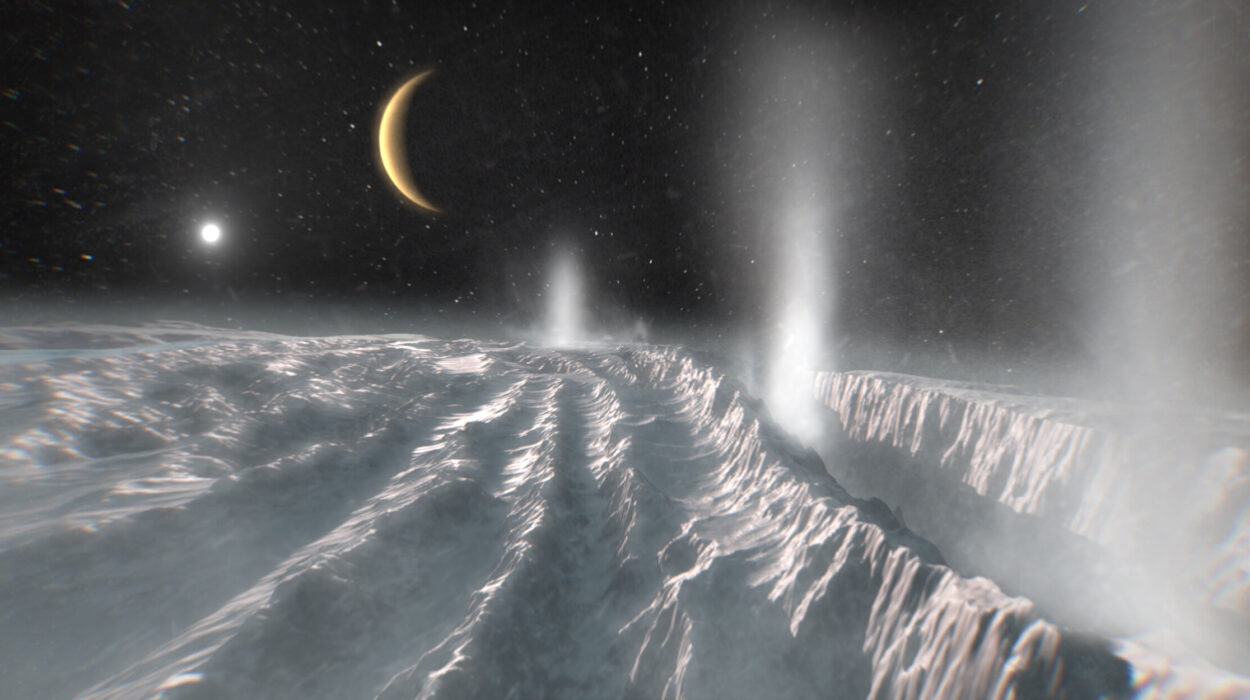In the southern skies, far beyond the shimmering stars we see with the naked eye, lies a ghostly relic of a cosmic cataclysm—a remnant of a dead star that once blazed with unimaginable fury. For tens of thousands of years, it has quietly expanded in the Large Magellanic Cloud, a satellite galaxy of our own Milky Way. But now, thanks to a global team of astronomers and a symphony of radio waves, this stellar grave has been revealed in stunning new detail—and it’s much larger, and stranger, than anyone expected.
Meet Veliki, a newly renamed supernova remnant that is rewriting the story of stellar death and rebirth.
A Cosmic Footprint, Hidden in Plain Sight
Officially known as SNR J0450.4−7050, this supernova remnant (or SNR) was already thought to be one of the larger known structures in the LMC. But when astronomers led by Zachary J. Smeaton of Western Sydney University took a closer look—combining the power of the Australian Square Kilometer Array Pathfinder (ASKAP), MeerKAT in South Africa, and a fleet of other telescopes—they discovered something extraordinary.
Faint filaments of gas and dust extended well beyond the previously measured boundaries, stretching the remnant’s size to a staggering 489 by 264 light-years. For comparison, if our own solar system were placed inside this vast bubble of stellar debris, it would be dwarfed beyond comprehension—hundreds of times over.
In honor of its monumental size, the astronomers gave it a fitting nickname: Veliki, the Serbian word for “large.”
But Veliki isn’t just big. It’s bizarre.
The Beautiful Chaos of a Star’s Afterlife
When a star dies in a supernova, it doesn’t simply vanish. It explodes with enough energy to outshine an entire galaxy, and what’s left behind is a swirling, expanding shell of gas and energy—an SNR—that slowly merges with the surrounding interstellar medium (ISM) over tens of thousands of years.
Veliki, estimated to be around 45,000 years old, is one of these remnants. But unlike many others, it displays a complex, filamentary structure—a kind of cosmic cobweb where inner and outer shells twist and radiate in delicate threads. It is, in the words of the researchers, “a unique and morphologically rich structure.”
Through their multi-wavelength campaign, the team uncovered a bright hydrogen-alpha shell, glowing like the embers of a dying fire. This signal tells astronomers that radiative shocks—waves of energy moving through the gas—are dominating the scene. It also helps paint a picture of a remnant that is more evolved than it appears at first glance.
Yet even more intriguing is Veliki’s behavior in radio wavelengths.
Radio Waves Reveal a Mystery
Most SNRs emit radio waves through synchrotron radiation—the result of fast-moving electrons spiraling through magnetic fields. This emission tends to fade over time as the shock wave slows and the gas cools.
But Veliki bucks the trend.
Its radio surface brightness is unusually high for an SNR of its size and age. Even more curious, it exhibits one of the flattest average radio spectral indices ever recorded in this category of remnants—a measurement that usually suggests either a very young remnant or something else entirely.
To explain this paradox, the researchers turned to theory.
The leading hypothesis? Veliki may be a fully radiative SNR—a stage where the remnant’s shock wave has slowed enough that cooling from radiation becomes the dominant force shaping its structure. In such cases, the shock compression ratio increases, amplifying the density and brightness of the gas. Combined with possible thermal (bremsstrahlung) emission, which occurs when electrons are deflected by ions, this could explain both the enhanced radio brightness and the flatter spectrum.
In simpler terms: Veliki may be glowing brighter and behaving differently because it has entered a rare, thermally driven phase of its evolution—one we don’t often get to observe in such detail.
Looking Beyond the Edge of What We Know
Veliki’s unusual features make it a cosmic laboratory, a place where theories about supernova remnants, interstellar matter, and galactic ecosystems collide. Its size and shape tell a story of an explosion so powerful it carved out a vast cavity in space. Its structure reveals how the blastwave danced with the dust and gas around it, sweeping up material, folding magnetic fields, and setting electrons loose to spiral and sing in radio waves.
But this is only the beginning.
“Further observations of Veliki, especially those focused on its environment, are required,” the team writes in their report, published on June 18 on the preprint server arXiv. To truly understand how and why this remnant behaves as it does, astronomers need more data—especially about the region surrounding it, including nearby gas clouds, magnetic fields, and remnants of the star that detonated.
And then there’s the deeper question that lingers: What kind of star was Veliki before it exploded? A massive blue giant? A binary white dwarf system? The answer could illuminate not only this remnant’s past, but the very process by which galaxies recycle material to create the next generation of stars.
A New Era of Galactic Archeology
Veliki is not alone. The Large Magellanic Cloud, as a relatively close and well-mapped galaxy, has become a favored destination for scientists trying to understand the full life cycle of stars. Studying SNRs outside our own Milky Way removes the clutter of our galactic backyard and offers a clearer window into the interactions between dying stars and their environments.
In this sense, astronomers are not just looking at debris. They’re looking at echoes—echoes of ancient explosions that helped shape galaxies, stir cosmic winds, and seed the space between stars with the raw materials of life.
Every measurement of Veliki is a measurement of time, of transformation, of what it means for something to end violently but contribute to something new.
The Silent Pulse of a Star Long Gone
If you were to fly to the edge of Veliki and hover there—light-years above a distant galaxy—you wouldn’t hear the blast that once ruptured a star. That sound is long gone, stretched across millennia and space. But you might sense the still-expanding wave of heat and energy, the delicate tendrils of gas glowing in infrared, the silent hum of electrons flashing through radio waves.
You’d be witnessing the afterlife of a star. And thanks to the precision and passion of astronomers across continents and hemispheres, we’re getting closer than ever to understanding it.
From a name hidden in a catalog—SNR J0450.4−7050—to a cosmic marvel known as Veliki, this supernova remnant reminds us that even in death, stars speak. Sometimes in whispers. Sometimes in flares. But always in light.
And now, in stories we can share.
Reference: Z. J. Smeaton et al, Study of a giant Large Magellanic Cloud Supernova Remnant, Veliki (J0450.4-7050), arXiv (2025). DOI: 10.48550/arxiv.2506.15067






